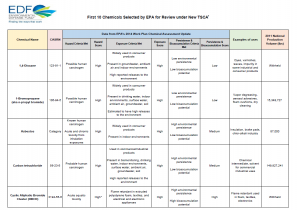Richard Denison, Ph.D., is a Lead Senior Scientist.
In the many conversations I have had over these last many years about the Toxic Substances Control Act (TSCA), the single thing that most resonated with people about why the old law didn’t work was about new chemicals. Folks were stunned when they learned that the old law didn‘t require our government to review chemicals and determine they were safe before they were allowed onto the market. People simply assumed this was the case and were shocked to find it wasn’t. I heard repeatedly, what could be a more basic need to ensure protection of the public’s health?
That is why many in Congress worked so hard to drive improvements to the new chemicals provisions in the new law – that, and a clear understanding of the many ways in which the old law hamstrung EPA when it came to new chemicals. In my view, these reforms and robust implementation of them by EPA are absolutely essential to the task of restoring public and market confidence in our national chemical safety system – the shared objective that allowed disparate stakeholders and lawmakers to come together to support the Lautenberg Act.
[pullquote]For too long, economic factors have dominated over the public’s right to expect that chemicals to which they may be exposed will not be allowed into use without adequate assurance of their safety. That has undermined consumer confidence in our chemical safety system. The public understands that the most efficient and effective stage at which to provide assurance of safety is before commercial production and use begins, rather than waiting and then having to try to mitigate risks that arise after a new chemical is embedded in commerce.[/pullquote]
I have blogged previously about why the new chemicals reforms in the new law represent a balanced approach, on the one hand, ensuring that the safety of new chemicals is carefully examined and a reasonable assurance of safety is provided before market entry; and, on the other hand, ensuring an efficient process that doesn’t unduly slow or create too high a bar for market entry.
Of course, even as it has supported the new law’s balanced reforms, the chemical industry did and continues to assert that the old new chemicals system worked just fine. I’ve always maintained that’s because it rarely required much of them. It’s not wholly surprising, therefore, that the industry is expressing angst over EPA’s implementation of the new requirements. Change is hard.
Bear in mind also that the new requirements of the law not only changed the status quo significantly, they also became effective immediately upon passage of the law, without any time given to EPA to migrate to the new regimen. That, too, has been a source of the growing pains felt by both EPA and the regulated community. Abrupt change is even harder.
But a broader and longer view of the new law is called for. The bulk of this post will describe why EDF believes that EPA’s implementation to date is not only consistent with the new law but in fact mandated by it, and why, despite initial growing pains, the new system will be a major improvement over the long run for both public health and business. But first … Read More »










